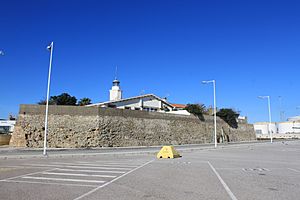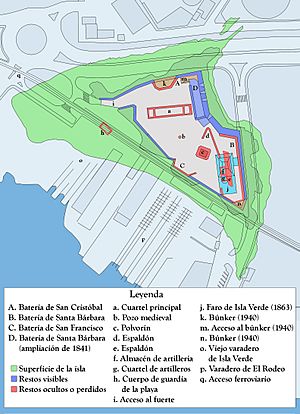Fuerte de Isla Verde facts for kids
The Fuerte de Isla Verde (which means Green Island Fort in English) was an old military fort in Algeciras, Spain. It was built on the Isla Verde (Green Island). This island actually gave the city of Algeciras its name, which comes from the Arabic words for "Green Island."
The island was long and thin, and it was located a short distance from the old part of the city. Even before the fort was built, there was already a place for cannons there in 1720. The fort itself was built in 1734, following plans by a military engineer named Juan de Subreville. It was later updated in 1745. The fort was shaped roughly like a triangle, just like the island. When it was first built, it had three main areas for cannons, called batteries.
Contents
The Fort's Cannon Areas
The Fuerte de Isla Verde had different sections where cannons were placed to defend the area. These sections were called batteries.
Original Batteries
The fort originally had three main batteries:
- The Algeciras Battery: This battery was on the eastern side of the island. From 1745, it was known as the San Cristobal Battery (St. Christopher's Battery). It faced north and controlled the sea routes leading to the New Town of Algeciras. It was about 20 metres (66 ft) wide and could hold four or five cannons.
- The Main Battery: This was called the Santa Barbara Battery (St. Barbara's Battery) from 1745. It faced southeast, looking towards the entrance of the Bay of Gibraltar. Its cannons could fire into the same area as another fort in Algeciras, the Fuerte de San García. This battery was about 40 metres (130 ft) wide and could hold thirteen heavy cannons.
- The San García Battery: This battery was on the western side of the island and faced southwest. From 1745, it was known as the San Francisco Battery (St. Francis' Battery). Its firing range overlapped with a cannon spot on the shore called Punta Rodeo. This was the smallest battery, only 9 metres (30 ft) wide, with space for two cannons.
Fort Defenses and Buildings
The island was surrounded by a strong stone wall. This wall was built to stop enemies from getting onto the island. Inside the fort, there were several important buildings:
- Living Quarters: Up to 70 soldiers could live here. These rooms were near the Algeciras Battery and had separate areas for officers and regular soldiers. There was also a place to store food.
- Gunners' Barracks: Soldiers who operated the cannons lived in a barracks (a building for soldiers) next to the San García Battery. Next to their barracks was a store for artillery equipment, like cannon carriages and spare parts. This building was protected by a large shoulder of earth to keep it safe from enemy fire.
- Main Magazine: In the middle of the island was the main magazine, which was a safe place to store gunpowder and ammunition. It had very thick walls to reduce the risk of an explosion if an enemy cannonball hit the building.
- Well: Drinking water came from a well built nearby.
- Entrance: The fort had only one entrance, located on the northwest side of the island, close to the beach. This was the most vulnerable spot, so it was made stronger with obstacles on the beach. It was also changed several times over the years to make it even more secure.
Changes Over Time
The fort went through many changes and challenges during its history.
19th Century Updates
In 1810, during the Peninsular War, many Spanish forts around the Bay of Gibraltar were destroyed by the British. This was done to prevent them from falling into French hands. However, the Fuerte de Isla Verde was not destroyed. Instead, it was updated and made stronger several times during the 1800s.
By 1821, the number of cannon batteries had increased to five. New firing positions were added so that soldiers could use muskets (old-fashioned rifles) from the fort walls. The cannon areas were also paved with flat stones, which made it easier to move the heavy cannons around. But as the century went on, the fort slowly started to fall apart. Problems with how it was built and damage from the sea caused it to weaken. In 1863, the Faro de Isla Verde (Green Island Lighthouse) was built on top of where the old San García Battery used to be.
Modern Era and Decline
By the early 1900s, cannons and military technology had improved a lot. This meant the Fuerte de Isla Verde was no longer as important for military defense. In 1919, a new group called the Board of Harbour Works took over the fort. They had to move all the stored ammunition to a new magazine at Punta de San García, which they also had to pay for.
A breakwater (a wall built into the sea to protect a harbor) was built north of the island. This helped create a sheltered area for building the docks of the Port of Algeciras. The fort was used for military purposes for a little longer. During the Second World War, it was used again. Two bunkers (strong underground shelters) with machine-gun posts were built, and about 40 soldiers were stationed there. A barracks and kitchen were also built for them.
However, in the 1960s, the fort was partly destroyed. The port expanded, and new warehouses and factories were built on the site where the fort once stood.
Protecting History
Even though much of the fort was destroyed, its historical importance was recognized.
- In 1985, the fort was given special protected status as a historical heritage site.
- In 1993, the Government of Andalusia gave it special recognition.
- In 2006, the Port Authority of Algeciras helped pay for work to dig up and restore the parts of the fort that were still there. Parts of the structure were rebuilt to try and make it look a bit like it did originally.
See also
 In Spanish: Fuerte de Isla Verde para niños
In Spanish: Fuerte de Isla Verde para niños



